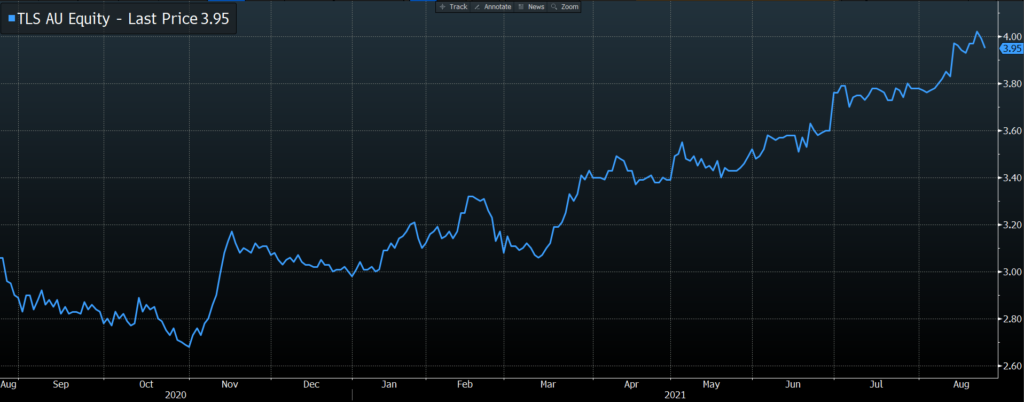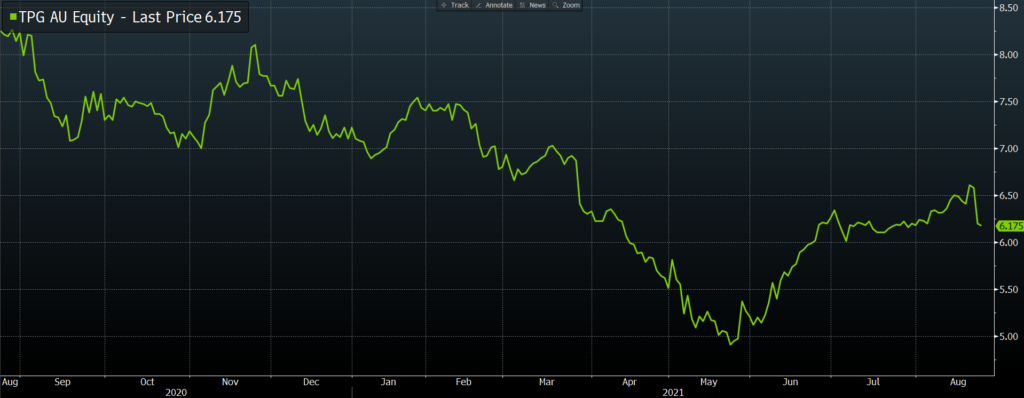The Delta variant and Chinese restrictions on iron ore imports has created an uneven earnings season, with some companies flourishing amidst lockdown restrictions (Consumer Staples and Healthcare), and others being impacted by increasing uncertainty (Energy, Materials).
Within the telecommunications industry, results have been mixed – companies within the sector are generally more defensive and as such display less volatility/more resilience against the ebb and flow of COVID-19 lockdowns.
However, significant developments have still been revealed within earnings releases, with the headwind of NBN and the tailwind of the 5G rollouts providing guidance on the future trajectories of both Telstra (ASX: TLS) and TPG Telecom (ASX: TPG).
Moreover, the sale of 49% of Telstra’s InfraCo Towers business at a healthy EV/EBITDA multiple of 28x could potentially mark the beginning of a series of quality infrastructure assets sales by industry incumbents, given the strong demand from superannuation and sovereign wealth funds.
In today’s note, we will cover the telecommunications industry, analysed through the lens of the two largest industry incumbents – Telstra and TPG.
This will be the 3rd instalment of our reporting season series, which has to date covered:
Telstra – NBN Headwinds but Positive Mobile Results
Telstra saw its first EBITDA growth since FY2018, coming in at $6.7bn for FY2021, with forecasts remaining strong for the coming years.
However, the key takeaway was the underlying split of these earnings, with growth being driven primarily by mobile, which saw an increase in both Average Revenue Per User (ARPU) and subscribers.
Nevertheless, the NBN-related headwinds which have plagued Telstra over the past few years have accelerated, with both fixed broadband enterprise and fixed broadband wholesale connections experiencing faster than expected declines.
These headwinds should continue to persist and may accelerate with increased competition from new entrants into the market.

Source: Bloomberg
Despite this, the investment thesis for Telstra has remained unchanged.
They are the best placed in the Australian mobile market in terms of the rollout of 5G infrastructure, which should see an increase in postpaid mobile subscribers. This advantage will serve invaluable, with Telstra already able to provide 5G to 75% of Australians.
For further details on the 5G rollout, please refer to Darren’s excellent note.
As expected, Telstra also announced a share buyback of $1.35bn from the sale of 49% of InfraCo Towers to a consortium including the Future Fund, Commonwealth Superannuation Corporation, and Sunsuper. This was made at an EV/EBITDA multiple of 28x, well above the EV/EBITDA of around 8x at the time of sale for Telstra.
The sale was made possible from the restructuring Telstra has been undergoing, where they split their assets into 3 separate entities:
- InfraCo Fixed: own and operate fibre assets, data centre exchanges and subsea cables
- InfraCo Towers: own and operate mobile towers
- ServeCo: own and operate the radio access network, mobile spectrum and customer service functions
Telstra will likely look to monetise further assets while there is strong demand for quality infrastructure assets from superannuation funds and other sovereign wealth funds.
The most likely candidate would be InfraCo Fixed – which delivered a $1.65bn EBITDA in its first full year of operation, implying a valuation of $46bn at the same multiple used for the InfraCo Towers (28x).
This valuation would be slightly under the entire market cap of Telstra, and as such could offer potential capital upside for investors.
TPG – Positive Cost Synergies, but Declining Mobile ARPU and Subscriptions
TPG delivered a mixed result, with a 1H EBITDA of $886m, increasing 4% from the prior period despite price degradation and market share losses in mobile.
Earnings growth was able to come from cost synergies with its merger with Vodafone Hutchinson Australia, as well as some subscriber growth in their fixed business.
Going forward, TPG will look to generate revenue growth from its 5G rollout, as well as Fixed Wireless, and continue to work towards its target of $70m in synergy related cost reductions by the end of the year (with $38m achieved in 1H).
Moreover, TPG believe they will be able to improve their mobile business which has been impacted by COVID restrictions, with growth expected once its 5G networks reach scale in major cities.

Source: Bloomberg
TPG also indicated that they are undertaking a strategic review in regards to the sale of their tower assets, which consists of 5,800 sites, including 1,200 sites where passive infrastructure is owned by TPG.
These assets could be sold for up to $1.2bn when using similar valuations to Telstra’s sale, and would subsequently provide capital upside for shareholders.
This opportunistic sale comes at a time where quality infrastructure assets are being demanded at a premium and could offer a boon to shareholders at an inflection point for the company – given the current margin compression from NBN and the further capex required to meet 5G distribution targets in major cities.
Time for Telecommunications?
Whilst the industry hasn’t been in the limelight as much as it used to, increased demand for quality infrastructure assets from superannuation and sovereign wealth funds has the potential to deliver enhanced shareholder returns.
The potential value of these cash flows has been elevated due to the premium paid on Telstra’s InfraCo towers and could be the first of many asset sales in the years to come.
As risk sentiment continues to increase, these defensive stocks could come back into favour, and can play a role in well-rounded portfolios through offering protection from market volatility without significantly sacrificing returns.
The views expressed in this article are the views of the stated author as at the date published and are subject to change based on markets and other conditions. Past performance is not a reliable indicator of future performance. Mason Stevens is only providing general advice in providing this information. You should consider this information, along with all your other investments and strategies when assessing the appropriateness of the information to your individual circumstances. Mason Stevens and its associates and their respective directors and other staff each declare that they may hold interests in securities and/or earn fees or other benefits from transactions arising as a result of information contained in this article.



